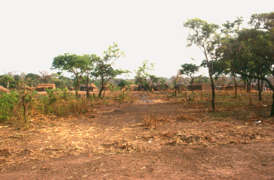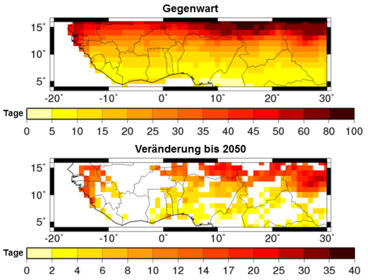Tropical Deforestation and Land Use Accelerate Climate Change in Tropical Africa
What is the importance of land surfaces in the climate system? The diverse processes in vegetation cover and soil affect atmospheric events in complex ways.
This is illustrated in Figure 1. Land cover determines the radiation properties (albedo) of the earth's surface, vegetation cools the surrounding air masses through its evaporative capacity (transpiration and evaporation) and promotes air mass exchange in the lower atmosphere (turbulence). The roots cause more infiltration and less surface runoff and erosion. However, in many areas of Africa, natural vegetation cover and soil are severely degraded by slash-and-burn agriculture (Fig. 2) and intensive livestock production (Fig. 3). This represents an important additional mechanism in man-made climate change, especially in Africa.
Future Climate Change in the Context of Greenhouse Gases and Land Use Change
A few years ago, the climate working group at the University of Würzburg was the first to investigate the effects of land use changes on future climate change in North and Central Africa by means of a high-resolution climate model and to compare them with the effect of increasing greenhouse gas concentrations. The calculated climate changes up to the year 2050 indicate a significant temperature increase of up to 4°C and an equally striking decrease in precipitation of up to 500 mm per year (Fig. 4). Land use changes contribute about one-third to warming and almost fully to drier conditions. At the same time, dry periods during the rainy season will lengthen by 2 to 20 days, which will lead to a narrowing of the zone of rainfed agriculture (Fig. 5).
Implications for Food Security and Malaria Incidence
Most agricultural crops in tropical West Africa are not irrigated and consequently suffer crop losses when summer dry spells exceed 10 to 15 days. If the climate changes shown above are applied to the yield of typical crops in Benin, yield losses of 5% to 25% compared to the reference year 2000 will predominantly occur by 2025. Only cotton, which is mostly irrigated, and the drought-resistant varieties yams and cassava prove to be relatively stable in the face of climate change. The expected decline in harvests contrasts with the rapidly growing African population and will require more careful management of natural resources in the form of forest, savannah and soil in the future.
Contact & Links

Prof. Dr. Heiko Paeth has been Professor of Climatology at the University of Würzburg since 2006. Since his studies of geography, meteorology and geology he has been dealing with questions of man-made climate change. The focus is on the manifestations and consequences of future climate change in Africa, Europe and Asia. To investigate these questions, Heiko Paeth develops and operates high-resolution climate models that can be used to derive detailed statements about regional climate changes and the role of human activities.












